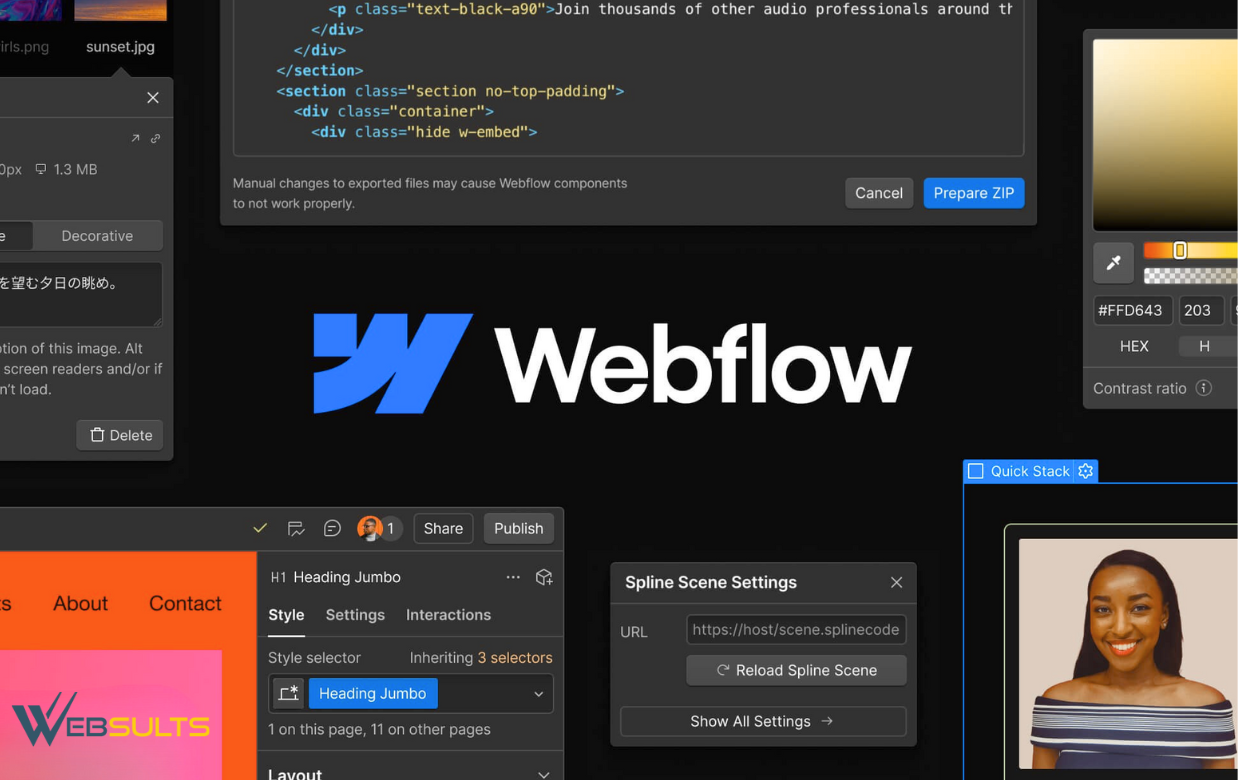Founded in 2012, Webflow is a visual website development platform that allows designers and business owners to create fully functional websites without writing code. It has transformed the Webflow website development landscape by allowing creative teams and entrepreneurs to bring design ideas to life faster and more efficiently. Understanding Webflow’s history and development helps businesses recognize its role in modern digital marketing and why it may be the perfect tool for your next Webflow website development project.
Platforms such as Webflow can improve design agility, streamline workflows, and reduce development time for businesses exploring custom website development. According to Google Developers, websites built with clean, compliant code tend to perform better in search results — a standard Webflow helps teams maintain through its W3C-compliant output.
The Founding of Webflow
Webflow was founded in 2012 by Vlad Magdalin, Bryant Chou, and Sergie Magdalin. The team’s mission was to simplify website development and make it accessible to non-programmers through a visual drag-and-drop interface. This new approach to Webflow website development empowered designers to build professional sites without relying solely on developers.
For small business owners, startups, and marketing teams, this meant more creative control and shorter turnaround times. The ability to design visually while generating clean, compliant code has made Webflow website development a valuable solution for both design agencies and businesses pursuing digital growth.
Need help comparing Webflow and WordPress for your business? Our web design experts can help you choose the best platform for your needs.
The Development and Evolution of Webflow
While Webflow gained attention quickly, its success wasn’t instantaneous. The platform’s early versions were focused on single-page designs and basic layouts. Over time, Webflow website development evolved into a full-scale content management system (CMS) with dynamic content features, responsive grid layouts, and built-in SEO tools.
Today, Webflow includes advanced collaboration options, AI-assisted design suggestions, and scalable hosting — helping agencies streamline both creative and technical processes. According to HubSpot’s Web Design Trends Report, visual-first builders like Webflow are driving a shift toward faster and more agile website development workflows.
Webflow’s Growth and Popularity
The design and development communities have widely embraced Webflow, helping it grow into a leading no-code solution. Millions of designers, freelancers, and agencies now use Webflow website development to create custom websites for clients across industries.
From small businesses to Fortune 500 brands, the appeal of Webflow website development lies in its ability to merge design freedom with technical precision. Companies such as Nutrisense, IMB Bank, and Oyster have all leveraged Webflow’s responsive design capabilities to launch high-performing websites that blend aesthetics and functionality.
Curious how your business could benefit from a similar approach? Explore our SEO services and learn how we integrate technical optimization with user-centered design.
Key Features and Innovations
The strength of Webflow website development lies in its combination of visual creativity and solid technical architecture. Core features include:
-
Drag-and-drop visual editor that generates clean HTML, CSS, and JavaScript.
-
Integrated CMS for blogs, portfolios, and corporate websites.
-
SEO-ready settings, such as customizable meta tags, schema options, and sitemap generation.
-
E-commerce functionality for online stores and product catalogs.
-
Built-in hosting and collaboration tools for streamlined team workflows.
The platform automatically generates code that aligns with W3C web standards, helping ensure accessibility and long-term performance. Businesses working with Webflow can maintain scalable, visually engaging sites without managing complex technical stacks — a major step forward in Webflow website development.
Learn how combining digital marketing with strong Webflow builds can enhance site conversions and brand visibility.
Comparison Table: Webflow vs Competitors
| Platform | Code Flexibility | SEO Control | Ease of Use | Ideal Users |
|---|---|---|---|---|
| Webflow | Medium–High | Strong | Moderate | Designers, agencies |
| WordPress | High | Excellent | Moderate | Bloggers, developers |
| Squarespace | Low | Basic | High | Beginners, small businesses |
| Wix | Low–Medium | Basic | Very High | Beginners |
Webflow sits between design precision and technical scalability. It offers more customization than template-driven tools, making Webflow website development ideal for agencies that prioritize creative control and clean front-end output.
Webflow’s Role in the No-Code Movement
The no-code and low-code revolution has democratized web development. Webflow leads this movement by allowing creators to build interactive, responsive websites without deep programming skills. Unlike traditional CMS tools, it lets users modify layouts, add animations, and connect APIs visually — bridging creativity and technical precision.
According to Stanford University’s Digital Transformation Study (2023), no-code tools can reduce time-to-market by up to 70%, which explains why marketing teams increasingly rely on platforms like Webflow to deploy campaigns faster. This aligns with Websults’ experience helping clients accelerate launches through Webflow website development paired with analytics and SEO strategies.
Challenges and Competitors
While Webflow website development provides flexibility and visual control, it has limitations. The platform’s learning curve and pricing model can be challenging for beginners or budget-conscious startups. WordPress still holds an advantage in open-source flexibility and plugin variety, while Webflow excels in clean design output and direct publishing workflows.
According to Google Search Central, site performance and structure are key in SEO success. Webflow’s auto-optimized code and fast hosting help meet these requirements, making it an attractive solution for designers and marketers.
Webflow Today
As of 2025, Webflow continues to grow rapidly, powering over 0.7% of all websites worldwide. Its user community of 85,000+ active developers and designers shares templates, tutorials, and workflows across the official Webflow University and global meetups.
With new AI-based design and accessibility features in development, Webflow’s future looks promising. For businesses weighing their options between WordPress vs Webflow, the decision depends on goals – SEO flexibility vs. design freedom.
To explore which CMS best suits your company, see Websults’ guide on choosing a CMS or contact our web design team for a personalized recommendation.
People Also Ask
1) What makes Webflow website development different from other platforms?
Unlike most template builders, Webflow gives users full design control while maintaining performance and SEO integrity. Designers can build pixel-perfect layouts without coding, and businesses can deploy content instantly. For agencies, Webflow website development provides visual flexibility with technical reliability — a rare balance in modern web tools.
2) Is Webflow website development good for SEO?
Yes. Webflow outputs clean, semantic code, allows on-page optimization, and automatically generates sitemaps and schema markup. When combined with a strong keyword and content strategy, Webflow website development can rank competitively alongside traditional platforms. For best results, pair it with structured analytics and a long-term content plan from a professional SEO services provider.
3) Who should consider Webflow website development?
Webflow website development is ideal for marketing teams, small to mid-sized businesses, and design agencies seeking creative freedom without losing technical stability. It’s particularly suited to businesses that value design precision, responsive layouts, and an efficient workflow between marketing and development teams.
About Websults
Since 2012, Webflow has grown from an ambitious startup to a global leader in no-code web design. It continues redefining the future of website development by giving creative professionals the power to build, iterate, and scale without traditional coding. The right choice for businesses evaluating CMS options depends on your digital strategy, content needs, and design goals.
Websults, a full-service web design and SEO agency based in Clearwater, FL, can help you evaluate whether Webflow or another platform best supports your vision.




